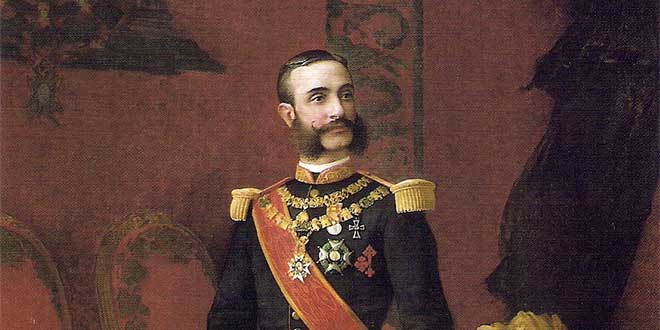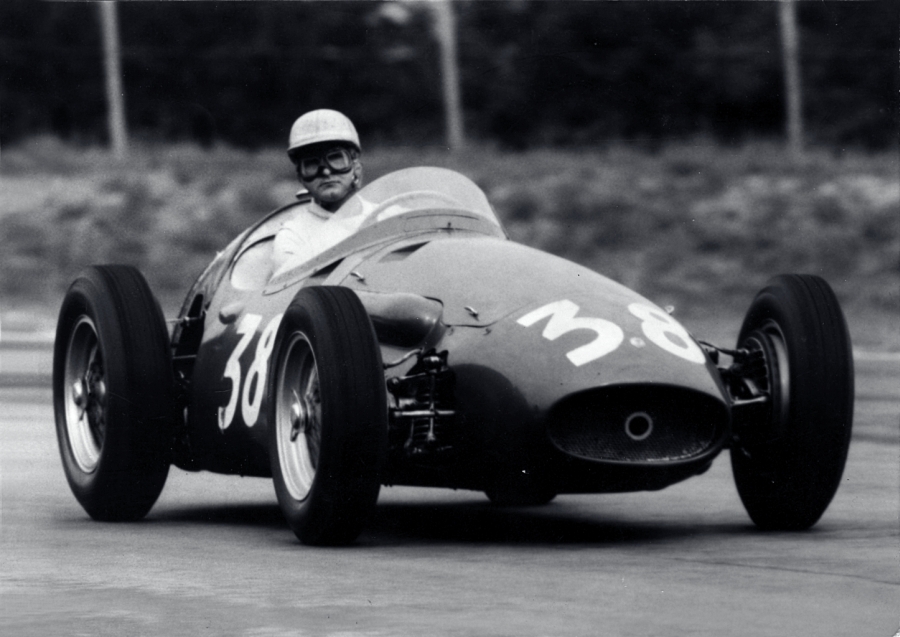November 28
Saint’s Day for Honesto, Urbano, Andrés, Félix, Esteban and Basilio.
1814 - Fernando VII of Spain creates the Military Order of San Hermenegildo.
_by_Goya.jpg)
Fernando VII of Spain by Goya - https://commons.wikimedia.org/
1821 - Panama proclaimed its independence from Spain and adheres to New Granada.
1838 - Construction of the Cathedral of Cádiz is completed.
1885 - Alfonso XII widow, Maria Cristina of Habsburg-Lorraine, swears fidelity to the heir to the throne and the Constitution.
1925 - In Barcelona, Catholic Action League Women protesting the placement of sculptural sketch of a statue in Plaza Catalunya.
1930 - José Ortega y Gasset published The Revolt of the Masses.
1936 - In Paracuellos de Jarama (Madrid), the playwright Pedro Muñoz Seca is shot (paracuellos massacres).
1963 - The Spanish Parliament approved the Statute of Autonomy for Fernando Poo and Rio Muni.
1983 - The Spanish writer Francisco Ayala is awarded the National Prize for Fiction.
2005 - Spain and Portugal: The tropical storm Delta crosses the Atlantic Ocean, affecting Madeira (Portugal) and the Canary Islands (Spain), where it causes electric cuts of more than a week.
2010 - CiU wins the Elections to the Parliament of Catalonia after two tripartite legislatures.
Births
1774 - Francisco de Paula y Marín, botanist (d. 1837)

King Alfonso X11 - https://historiaespana.es/
1857 - King Alfonso XII Alfonso was born in Madrid as the eldest son of Queen Isabella II. His official father, Isabella's husband Francisco de Asís, has been generally viewed as effeminate, impotent or homosexual, leading writers to question his biological paternity. There is speculation that Alfonso's biological father may have been Enrique Puigmoltó y Mayans, a captain of the guard. The relationship of the queen with Puigmoltó was so much of a public hearsay at the time that Francisco de Asís initially refused to attend the baptism ceremony of Alfonso (the heir apparent) even if he was eventually forced to do so. These rumours were used as political propaganda against Alfonso by the Carlists, and he came to be widely nicknamed "Puigmoltó" in reference to his supposed father. Others have assigned the fatherhood to Federico Puig Romero, who was murdered under unclear circumstances in 1866.
His mother's accession created the second cause of instability, the Carlist Wars. The supporters of the Count of Molina as king of Spain rose to have him enthroned. In addition, within the context of the post-Napoleonic restorations and revolutions which engulfed the West both in Europe and the Americas, both the Carlistas and the Isabelino conservatives were opposed to the new Napoleonic constitutional system. Much like in Britain, which subtracted itself from the liberal constitutional process, Spanish conservatives wanted to continue with the Traditional Spanish Organic Laws such as the Fuero Juzgo, the Novísima Recopilación and the Partidas of Alfonso X. This led to the third cause of instability of note, the "Independence of the American Kingdoms", recognized between 1823 and 1850.
When Queen Isabella II and her husband were forced to leave Spain by the Revolution of 1868, Alfonso accompanied them to Paris. From there, he was sent to the Theresianum in Vienna to continue his studies. On 25 June 1870, he was recalled to Paris, where his mother abdicated in his favour, in the presence of a number of Spanish nobles who had tied their fortunes to those of the exiled queen. He assumed the name Alfonso XII, for although no king of united Spain had borne the name "Alfonso", the Spanish monarchy was regarded as continuous with the more ancient monarchy represented by the 11 kings of Asturias, León and Castile also named Alfonso
After the revolution, the Cortes decided to set up a new dynasty on the throne. Prince Amadeo of Savoy, the younger son of King Victor Emmanuel II of Italy and a distant cousin of Alfonso by common descent from Charles III, was recognized as King of Spain in November 1870. During a tumultuous reign, Amadeo was targeted by assassination attempts and struggled with opposition from both Carlists and republicans while his own faction split. After the Carlists revolted and the Third Carlist War broke out, he abdicated and returned to Italy in early 1873.
Following Amadeo's abandonment, the First Spanish Republic was established, including the territories of Cuba, Puerto Rico and the Pacific Archipelagos. The first act of President Estanislao Figueras was to extend the abolition of slavery to Puerto Rico; Cuban slaves would have to wait until 1889. The republicans were not in agreement either, and they had to contend with a war in Cuba and Muslim uprisings in Spanish Morocco. In the midst of these crises, the Carlist War continued and the Carlist party made itself strong in areas with claims over their national and institutional specificity such as Cataluña and the Basque Country. This unrest led to the creation of a group in favour of the Bourbon Restoration, led by the moderate conservative Antonio Cánovas del Castillo.
Alfonso was well-educated and cultured, especially compared to his mother. His tutors took great care to have him educated in good schools and to familiarize him with different cultures, languages and government models throughout Europe. During the Franco-Prussian War, Alfonso relocated from Paris to Geneva with his family, and then continued his studies at the Theresianum in Vienna in 1872. Cánovas began to take responsibility for Alfonso's education with the goal of shaping him into the ideal king for the planned Bourbon Restoration, and next sent him to the Royal Military College, Sandhurst, in England. The training he received there was severe but more cosmopolitan than it would have been in Spain, given its atmosphere at the time.
On 1 December 1874, Alfonso issued the Sandhurst Manifesto, where he set the ideological basis of the Bourbon Restoration. It was drafted in reply to a birthday greeting from his followers, a manifesto proclaiming himself the sole representative of the Spanish monarchy. At the end of 1874, Brigadier Martínez Campos, who had long been working more or less openly for the king, led some battalions of the central army to Sagunto, rallied the troops sent against him to his own flag, and entered Valencia in the king's name. Thereupon the President resigned, and his power was transferred to the king's plenipotentiary and adviser, Cánovas. The 29 December 1874 military coup of Gen. Martinez Campos in Sagunto ended the failed republic and meant the rise of the young Prince Alfonso.
Within a few days after Canovas del Castillo took power as Premier, the new king, proclaimed on 29 December 1874, arrived at Madrid, passing through Barcelona and Valencia and was acclaimed everywhere (1875). In 1876, a vigorous campaign against the Carlists, in which the young king took part, resulted in the defeat of Don Carlos and the Duke's abandonment of the struggle.
Initially led by Cánovas del Castillo as moderate prime minister, what was thought at one time as a coup aimed at placing the military in the political-administrative positions of power, in reality ushered in a civilian regime that lasted until Primo de Rivera 1923 coup d'état. Cánovas was the real architect of the new regime of the Restoration.
In order to eliminate one of the problems of the reign of Isabel II, the single party and its destabilizing consequences, the Liberal Party was allowed to incorporate and participate in national politics, and the 'turnismo' or alternation was to become the new system. Turnismo would be endorsed in the Constitution of 1876 and the Pact of El Pardo (1885). It meant that liberal and conservative prime ministers would succeed each other ending thus the troubles.
This led to the end of the Carlist revolts and the victory over the New York-backed Cuban revolutionaries, and led to a huge backing both by insular and peninsular Spaniards of Alfonso. His government continued the operations of the Ministry for Overseas Affairs which began under his mother's reign. The ministry was responsible for the theft of indigenous human remains and artifacts throughout colonized lands from 1863 to 1899. To this day, the majority of the stolen bodies of indigenous peoples, some still displayed in Spanish museums, have yet to be returned to their ancestral lands.
Alfonso's short reign established the foundations for the final socioeconomic recuperation of Spain after the 1808–1874 crisis. Both European (the coastal regions, such as the Basque Country, Catalonia, and Asturias) and Overseas – Antilles and Pacific were able to grow steadily. Cuba and Puerto Rico prospered to the point that Spain's first train was between Havana and Camagüey, and the first telegraph in Latin America was in Puerto Rico, established by Samuel Morse, whose daughter lived there with her husband. Upon the American invasion of Puerto Rico, ten US dollars were needed to buy one Puerto Rican peso.
In November 1885, Alfonso died, just short of his 28th birthday, at the Royal Palace of El Pardo near Madrid. He had been suffering from tuberculosis, but the immediate cause of his death was a recurrence of dysentery.
In 1902, his widow Maria Cristina initiated a national contest to build a monument in memory of Alfonso. The winning design, by José Grases Riera, was erected in an artificial lake in Madrid's Parque del Buen Retiro in 1922.
Coming to the throne at such an early age Alfonso had served no apprenticeship in the art of ruling. Benevolent and sympathetic in disposition, he won the affection of his people by fearlessly visiting districts ravaged by cholera or devastated by 1884 Andalusian earthquake. His capacity for dealing with men was considerable, and he never allowed himself to become the instrument of any particular party. During his short reign, peace was established both at home and abroad, finances were well regulated, and the various administrative services were placed on a basis that afterwards enabled Spain to pass through the disastrous war with the United States without the threat of a revolution
1874 - Emilio Torres Reina Bombita, bullfighter. (d. 1947 in Sevilla)
1895 - José Iturbi, pianist and conductor (d. 1980)
1895 - Juan Artola, footballer (d. 1937)
1923 - Emilio Rodríguez Barros, cyclist (d. 1984)
1927 - Joan Ponç, Catalan painter (d. 1984)
1931 - Joan Guinjoan Gispert, Catalan composer, director of the Center for Documentation and Dissemination of Contemporary Music in Barcelona. (d. 2019 in Barcelona)
1936 - Celin Romero, Spanish-American guitarist (The Romeros)
1938 - José Antonio González Caviedes, politician (d. 1996)
1940 - Javier Sádaba, philosopher.
1942 - Manolo Blahnik, Spanish-English shoe designer
1957 - Gaspar Llamazares, politician.
1960 - Jorge Domecq, lawyer and diplomat
1960 - John Galliano, Gibraltarian-English fashion designer
1960 - Víctor Fernández, football trainer.
1961 - Ramón García,radio and television presenter.
1970 - Álex López Morón, tennis player
1975 - Juan Martín Díaz, Argentinian - Spanish padel player
1976 - Juana Acosta, Colombian actress nationalized Spanish.
1976 - Aitor Ocio Carrión, footballer.
1988 - Adrián Rodríguez, actor and singer
1585 - Hernando Franco, composer (b. 1532)
1939 - José Agustín Pérez del Pulgar, priest and physicist (b. 1875)
1966 - José Enrique Benito y Emerterio Ysbert Alvarruiz, also known as José Isbert, was an actor (b.1886 in Madrid)
1974 - Miguel Odriozola, geneticist and trade unionist (b. 1903)

1994 - Vicente Enrique y Tarancón, Cardinal.
1994 - Venancio Pérez, footballer (b. 1921)
